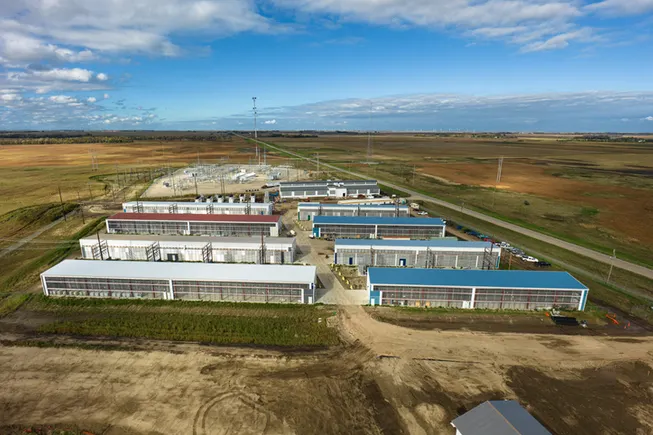Tony Qorri is vice president of construction at Dallas-based data center colocation provider DataBank. The opinions are the author's own.
The artificial intelligence revolution has completely transformed so many aspects of virtually every industry today. Companies have already achieved groundbreaking, lasting improvements and continue to dream of further innovations and benefits.
At the same time, AI is so transformative that it also raises new questions as many companies need to develop strategies to take advantage of all the advantages it has to offer, to outperform their competition, or both.
The data center industry is no different, and one part of our business – data center design and construction – could be even harder hit than most. Like any other company, we are used to constantly reacting to market demands and other external factors when building traditional enterprise data centers.

Tony Corri
Approval granted by DataBank
While these past conditions once represented predictable winds of change, AI has now created a perfect storm of innovation, opportunity and transformation as it designs and builds the next generation of AI data centers. Once-common, long-accepted practices and approaches are now becoming obsolete – seemingly overnight – forcing data center operators and their customers to think in new ways around data center construction.
AI infrastructure flexibility
This new environment requires infrastructure flexibility that adapts to customers' changing needs. This means they can offer multiple power, space and cooling configurations to meet their future computing needs without the need for complete redesigns.
While this flexibility has previously served enterprise and hyperscale customers well, AI workloads are now opening up a whole new dimension. Data center builders are now faced with “hard right” and “hard left” requests from various customers. For example, one may require full air cooling for network infrastructure, while another may be looking for extensive liquid cooling equipment for GPU-intensive operations.
These are not minor differences. They represent fundamentally different infrastructure approaches and completely new construction strategies.
AI data centers require specialized approaches that go far beyond traditional design considerations and project management approaches. In some cases, they present logistical and technical complexities that did not exist until recently.
Liquid cooling
The move to liquid cooling represents one of the most dramatic design changes. Until recently, most traditional data centers used raised floors and perimeter cooling, but more intensive AI workloads are now leading facilities to replace computer room air conditioning units with cooling distribution units. These systems use secondary cooling water circuits made from welded stainless steel components.
This change creates a domino effect that now requires specialized welding skills and stronger structural designs to support heavier heat storage systems. These impacts impact previously standard construction schedules and processes. It is more difficult to try to fit more specialized work into the same schedules while developing new structural designs.
Supply chain constraints make building AI data centers even more complex. Previous procurement approaches may prove inadequate when attempting to source specialty materials such as high-quality copper components or stainless steel tubing and control valves. This puts us at risk of limited availability and longer delivery times.
In response, data center builders must move two to three levels deeper into the supply chain than before. For example, instead of working exclusively with switchgear suppliers, consider developing direct relationships with circuit breaker manufacturers and cable suppliers. This is evidence of more dominoes falling: we need to predict facility needs years in advance and start negotiating letters of intent for raw materials before actual contracting occurs.
This deeper engagement creates a partnership model where suppliers now actively participate in the success of the project rather than just fulfilling orders. This new approach still requires careful consideration of economies of scale, but helps improve the supply chain security now required in AI infrastructure timelines.
Work challenges
Specialized mechanical and electrical jobs are extremely scarce today, making building AI data centers the most difficult aspect.
Estimates suggest that in North America a an additional 439,000 new workers are required to meet upcoming construction needs for data center projects. Additional research revealed the total number unfilled craft positions by 2033 there could be two million.
If this growing gap is not effectively managed, it can cause construction schedules and costs to spiral into unpredictable territory where previous general contractor relationships and current project management processes could falter.
Builders must predict labor needs up to three years in advance and, if necessary, involve contractors in preconstruction activities three to six months earlier. Instead of following traditional bidding processes, owners should engage contractors for design development and resource planning before breaking ground.
The scale of this challenge is evident across the industry. Projects that begin with predictable labor costs often undergo dramatic changes as construction progresses. It is not uncommon to see price increases of 20 to 30% for mechanical and electrical trades between phases of the same development.
This is simply the new reality of sourcing skilled labor from other markets with increased daily rates and competitive wages. It has reached a point where work escalation is now recognized in several active developments and markets.
Adapting to the speed of AI
One thing is clear: data center construction must adapt quickly to keep pace with the AI revolution. While these new challenges are unprecedented, they can also present new opportunities for operators who can find new solutions early in the process.
To be successful, all aspects of construction – from supply chains to labor partnerships – must now be treated as strategic investments rather than transactional relationships. As AI workloads continue to evolve, those data center operators who will thrive will be those who view adaptation not as an obstacle but as a potential differentiator in an industry that is redefining itself in real time.
